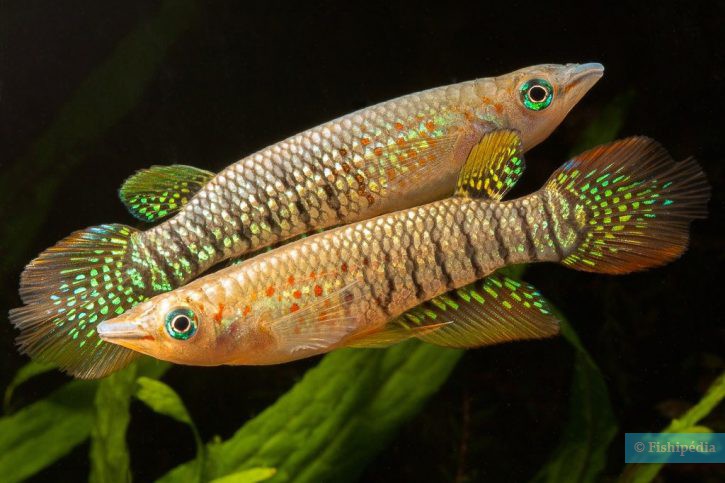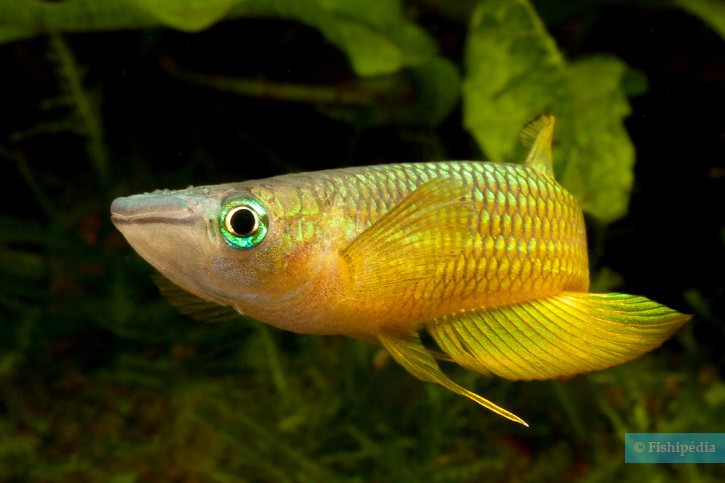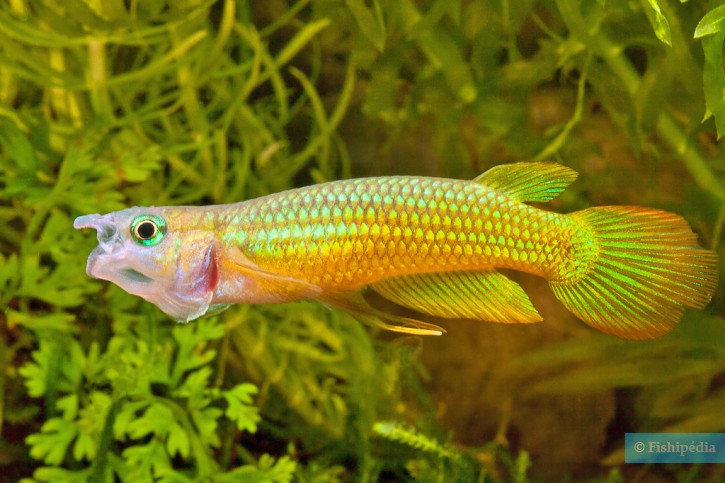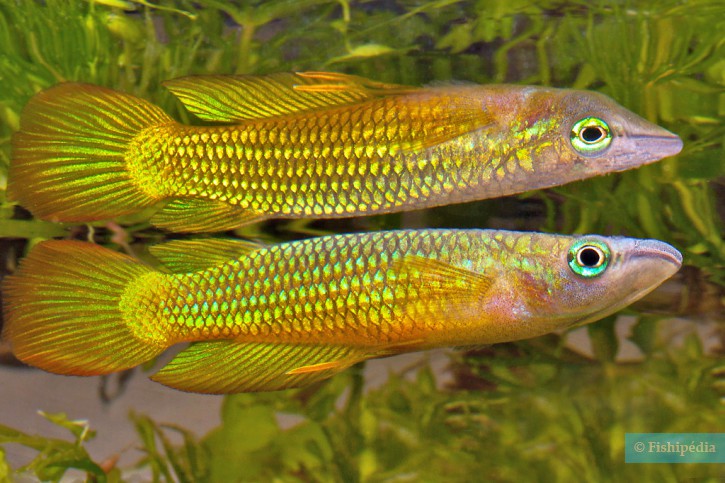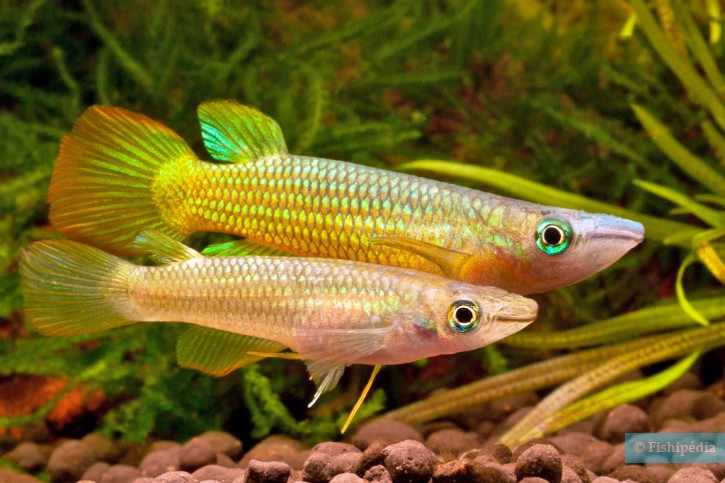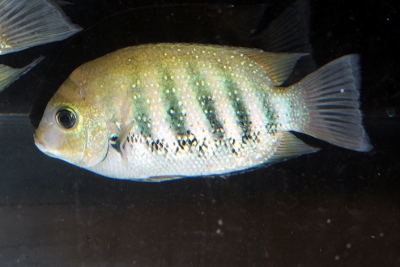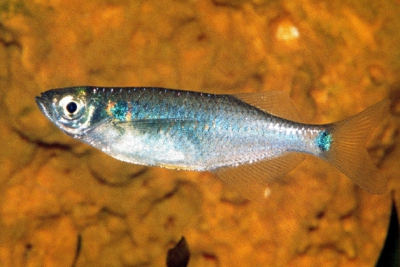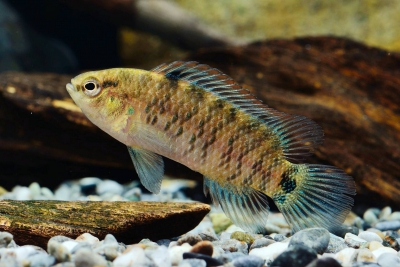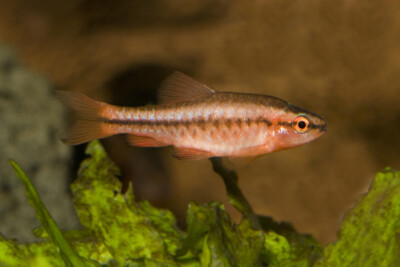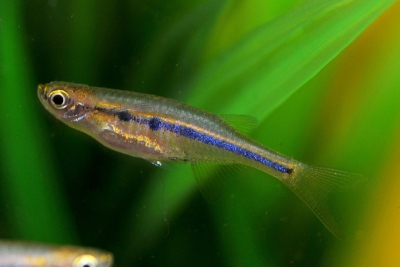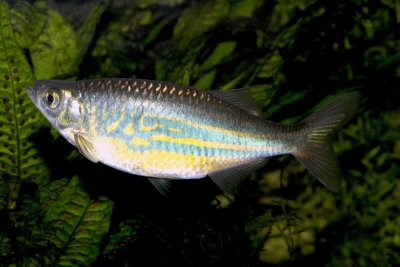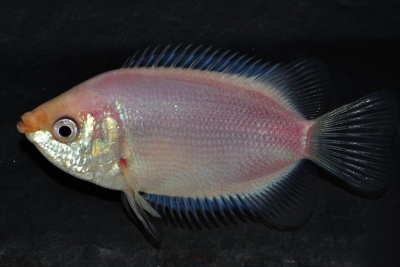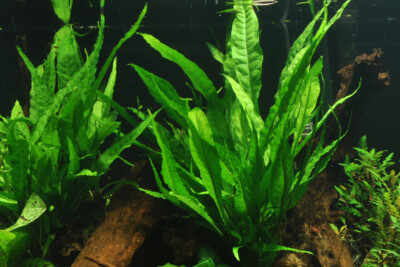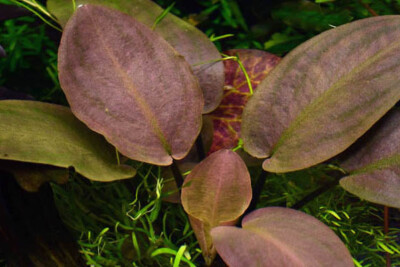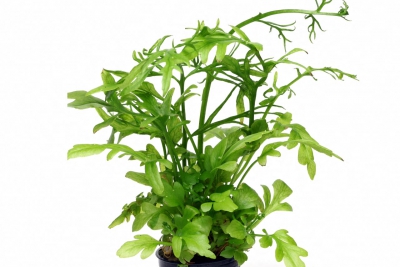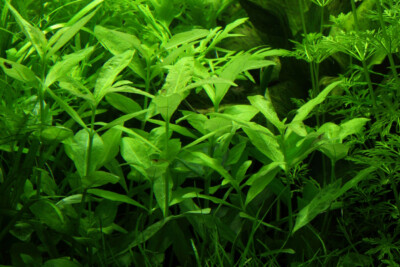striped panchax
| Scientific name | Aplocheilus lineatus |
|---|---|
| Descriptor | Valenciennes |
| Year of description | 1846 |
| IUCN category (World) | LC |
| Family | Aplocheilidae |
| Genus | Aplocheilus |
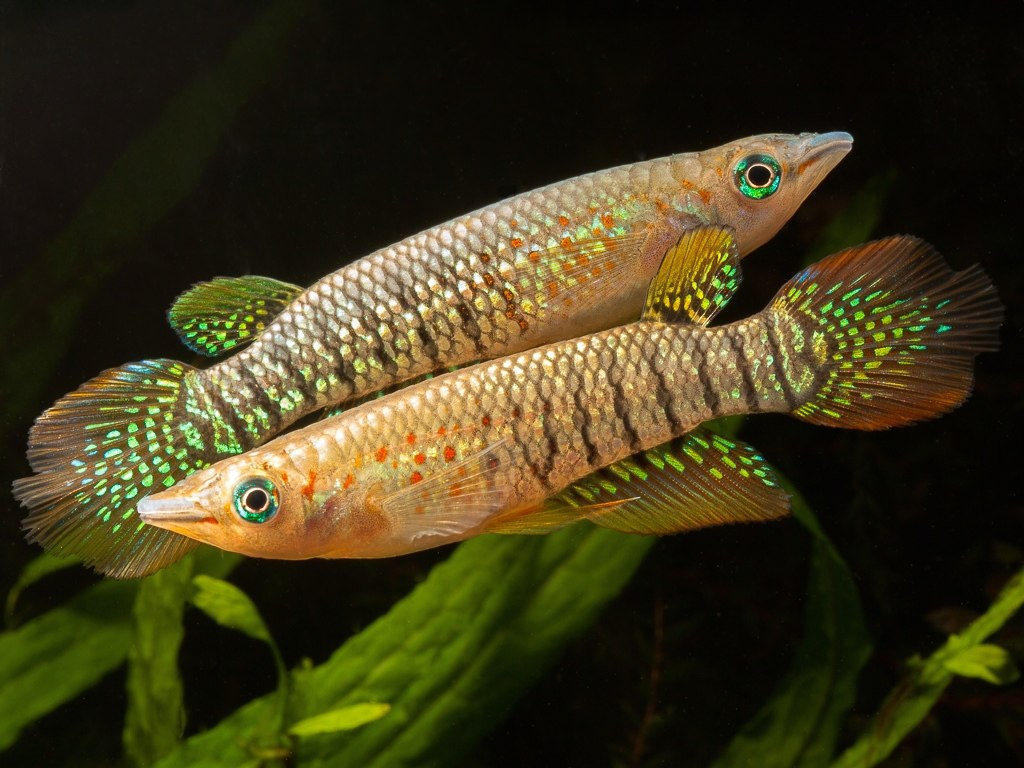

Introduction
The Aplocheilus lineatus, more commonly known as the striped panchax, is a killifish native to India.
Who is it?
Morphology
-
Type
-
Average size8 cm
-
Maximum size12 cm
-
Longevity3 year
-
ShapeRectangular
-
Type
-
Average size8 cm
-
Maximum size12 cm
-
Longevity3 year
-
ShapeRectangular
How to recognize This fish ?
The fish's upper profile is linear and its mouth is distinctly oriented upwards, indicating a preference for the surface.
Sexual dimorphism
Females are virtually uniform and their fins are colorless.
Behaviour & Life cycle
-
dietcarnivorous
-
Sociabilityliving in small groups
-
territorialNo
-
Way of livingdiurnal
Naturally, the striped panchax is a somewhat social fish that lives in small dispersed groups. It spends most of its time near the surface, waiting for anything that may fall into the water. It is an excellent jumper, using this ability for hunting and evading predators.
It is a relatively independent small predator that pays little attention to non-threatening neighbors. It is particularly effective at hunting insects and small fish.
Reproduction
-
Reproductionovipare qui pond sur substrat découvert
The striped panchax is an oviparous fish that lays eggs in vegetation.
Harmless species
This species does not represent any particular threats to humans when encountered in its natural environment.
Origin and distribution
Geographic distribution & Conservation
The Aplocheilus lineatus is found in peninsular India (central and southern areas) where it is widely distributed. The species occurs in two separate populations in India. It has disappeared from some parts of its original range following the introduction of invasive livebearers (Gambusia and Poecilia). The aquarium trade may also have had negative impacts on some populations.
It has been reported in Sri Lanka, but its presence there would need confirmation.
Overall, although still fairly common, populations of the striped panchax are declining in several regions of India.
Conservation status of populations (IUCN)
What is its habitat?
Natural environment characteristics
-
Temperature20 - 25 °C
-
pH (acidity)6.5 - 7
-
gh (hardness)3 - 13
-
FlowSlow
Biotope presentation
This fish lives in shallow waters, in streams and small high-altitude lakes, as well as in rivers, lowland rice paddies, swamps, and brackish waters. It is difficult to categorize all biotopes as it adapts to various environments.
It appreciates the presence of surface vegetation, where it finds refuge and the opportunity to hunt insects that have fallen into the water.
Species of the same biotope
Main recommendations for fishkeeping
Deontology
In order to preserve wildlife, if you acquire this animal, it must not be released into the wild. See also, the Fishipedia charter.
Fishipedia supports the practice of responsible and environmentally friendly aquarium keeping. We encourage maintenance if it is motivated by a desire to understand the biological functioning of living things and if it is done with respect for animal life.
We believe that aquaristics is an opening to the discovery of aquatic environments, especially freshwater, and that this knowledge is necessary to better protect and respect these environments. Logically, we refute the compulsive purchase of animals that would not find a sufficient and / or adapted place in the host aquarium.
Our recommendationsThese tips apply to adult species from breeding. With regards to water conditions, wild species or close relatives must be kept under the same conditions as in their area of origin.
-
Min volume50 liters
-
Population min5
-
Temperature20 - 25 °C
-
pH (acidity)6.8 - 7.2
CharacteristicsThe characteristics below apply for adult species. They correspond to an average of cases, validated in maintenance condition.
-
Difficulty breedingThe farming difficulty is relative. It depends on experiments already carried out with similar species. First, it takes into consideration the robustness of the species, the ease of recreation of a favorable environment and the general behaviour with the other inhabitants of the aquarium.easy
-
Robustnessrobust
-
Behaviourpeaceful
-
Availabilitystandard
Recommended equipment from our partners
-
Aquarium
-
Filtration
General reminders
It is strongly advised to read the complete dedicated file and to get information on the feedbacks of maintenance of the envisaged animal, this to avoid any potential conflict whose end result is generally the death of the individual (or the other inhabitants). It is important not to overload your aquarium to limit pollution. This will make maintenance easier.
In nature, animals are subject to weather conditions and live in waters with variable characteristics. The recommendations offered by our team for aquarium maintenance are a guidance and cannot be assimilated to scientific datas.
General reminder on maintenance datas
Le démarrage d'un aquarium est une partie primordiale pour l'équilibre et le bien-être des poissons. Lorsque l'on met en eau un aquarium, l'eau passe naturellement par un cycle biologique : le cycle de l'azote. Celui-ci dure environ trois semaines. Tous les 2 jours, nous vous conseillons de tester votre eau jusqu'à ce que le taux de nitrite soit à zéro pendant plusieurs jours d'affilée.
Pour accélérer ce cycle, vous pouvez utiliser un activateur de bactéries comme JBL Denitrol. Cette solution riche en bactéries vivantes et enzymes permet une mise en place rapide du cycle de l'azote. Les poissons peuvent alors être introduits plus rapidement.
Il est important de tester l'eau de son aquarium régulièrement pour maintenir un environnement sain pour les poissons et les autres habitants. Les tests d'eau permettent de mesurer les niveaux de différents paramètres tels que le pH, la dureté totale, ainsi que les taux de nitrates, de nitrites et d'ammoniaque.
Pour réaliser ces tests, vous pouvez utiliser des produits d'analyse spécialisés tels que JBL ProScan qui permet de réaliser un diagnostic de l'eau directement via un smartphone. Il existe également des coffrets de tests plus classiques de bandelettes, comme JBL PROAQUATEST.
En cas d’usage de l’eau du robinet, vous pouvez utiliser un conditionneur d’eau de type Biotopol de JBL pour éliminer les substances nocives comme le chlore, le cuivre, le plomb et le zinc. Les conditionneurs d'eau garantissent une meilleure santé aux poissons et une meilleure croissance des plantes.
Chlorine and chloramine are dangerous for the health of animals. Used to disinfect water, these agents are present in significant quantities in tap water. We recommend using an anti-chlorine agent every time you change the water. In addition to chlorine, treatments and medicines sold for aquarium use sometimes contain dangerous heavy metals in high doses.
Specific needs for the striped panchax
The striped panchax is a species which lives naturally at a temperature between 20 °C and 25 °C. For proper maintenance, the temperature should never exceed the 28°C for long periods. Nitrate levels should remain below 50mg/L. To keep the water clean and unpolluted, plan on changing 20% to 30% of the water volume each month.
Breeding this species is accessible to any hobbyist. It is recommended to follow some basic rules and to be rigorous to achieve a good maintenance.
This species is particularly common in the aquarium trade. Animals from long-term breeding are usually acclimatized at a temperature of about 26 °C in neutral water.
Cohabitation & Environment
The striped panchax is a fish which it is advisable to maintain in specific aquarium. Associating it with other species is not fundamentally impossible but a documentation work is necessary for the constitution of the population. Being a living in small groups fish, it is advisable to install at least 5 individuals in an aquarium of 50 liters minimum. Group maintenance is a prerequisite to ensure their well-being. Lonely individuals tend to quickly become stressed and become especially susceptible to disease. Although sometimes certain groups can "merge", mixing several gregarious species living in the same zone of life is not recommended if the volume is not consequent.
Tips for feeding
The striped panchax is carnivorous.
This species can eat dry food (flakes, pellets), fresh food and frozen food. To avoid deficiencies, it is recommended to vary the types of food.
You should not overfeed your residents to avoid polluting the water. For most species, it is better to feed a few small portions each day rather than one large meal.
Food recommendations from our partner JBL - Products PRONOVO
-
Granules
-
Flakes
Reproduction protocol
-
Maintenance difficultyeasy
-
egg-laying protectionYes
Reproduction of this species in an aquarium is considered easy. Ideally, it takes place at a temperature of around 22 ° C for a pH of 6.5 .
Hybridization risks
In general, it is advised not to mix several species of the same genus or different varieties of the same species, to avoid the risks of hybridization.
These animals might interest you
These plants might interest you
Plants play a crucial role in aquariums, both for their ability to filter water by absorbing excess nutrients and for their aesthetic contribution. They provide fish with natural hiding places, can serve as breeding sites, and generally help maintain the overall balance and optimal conditions of the aquarium. The selection presented here includes species from the same regions as the species described on this page, although they do not necessarily come from its exact natural biotope.
To go further
Sources & Contributions
Participation & Validation
The Fishipedia team and specialist contributors are committed to providing high-quality content. However, although the information comes from scientific sources or testimonials from specialists, the cards may contain inaccuracies.

Robert Allgayer

Benoit Chartrer
Translation
Translation done with the valuable contribution of our translators, who make this information available to a wider audience. We sincerely thank them for their commitment.
